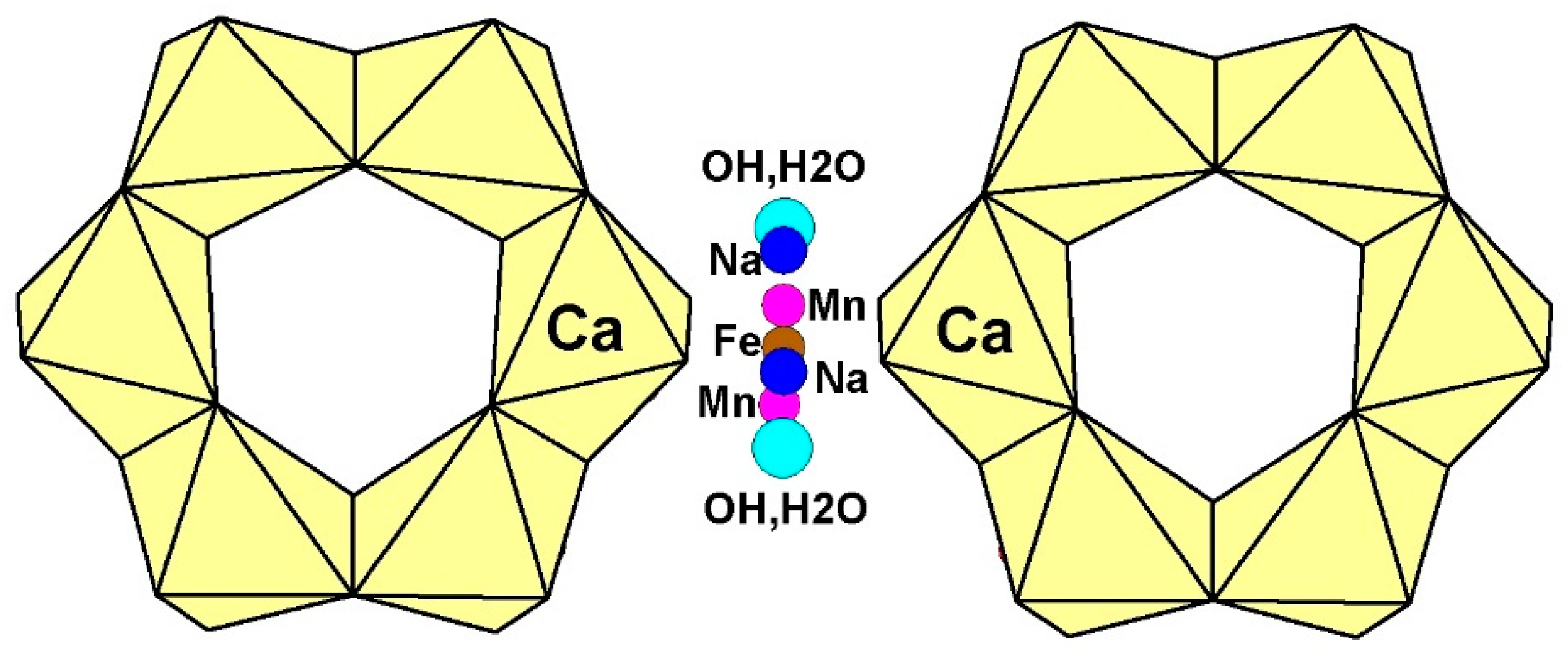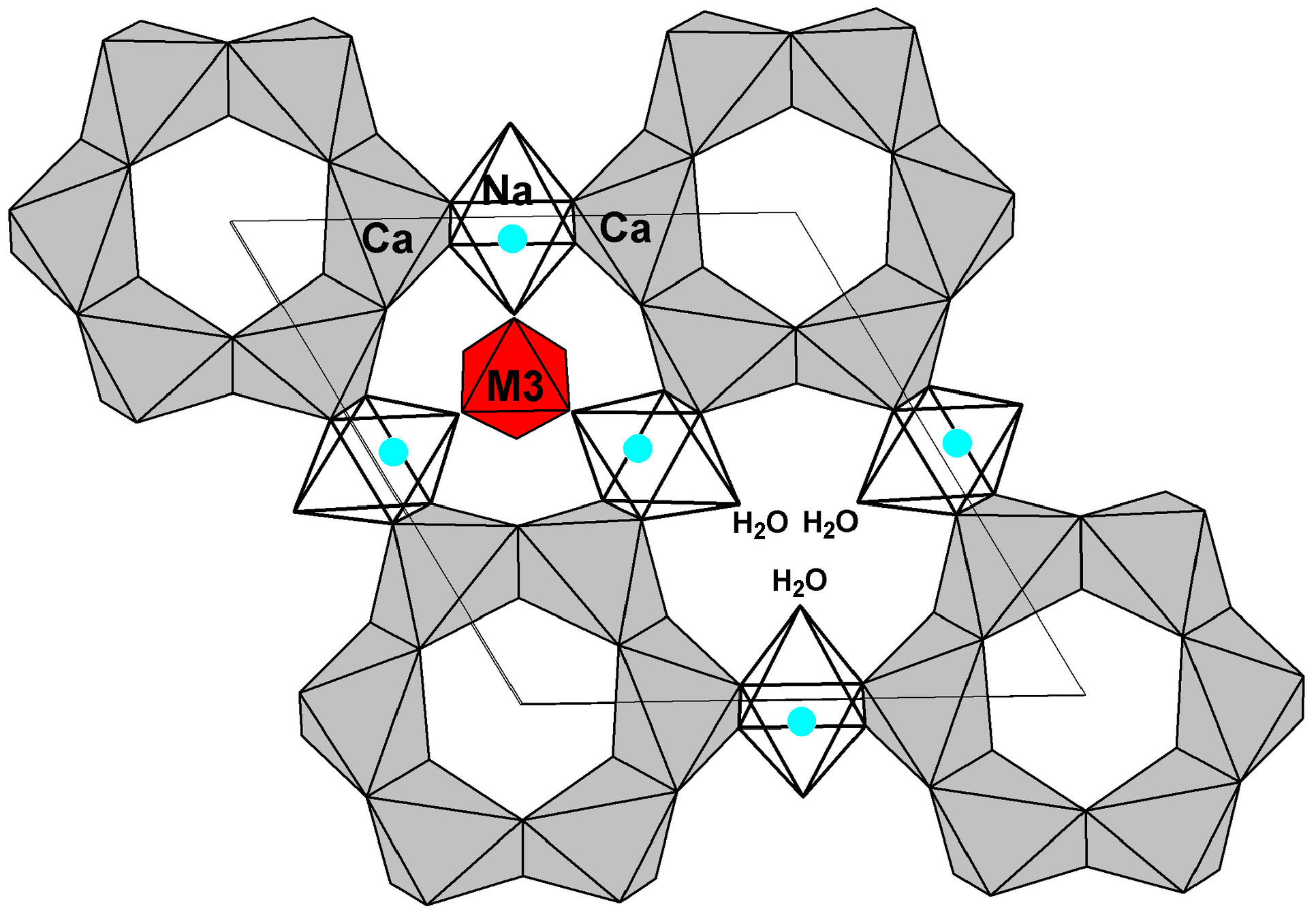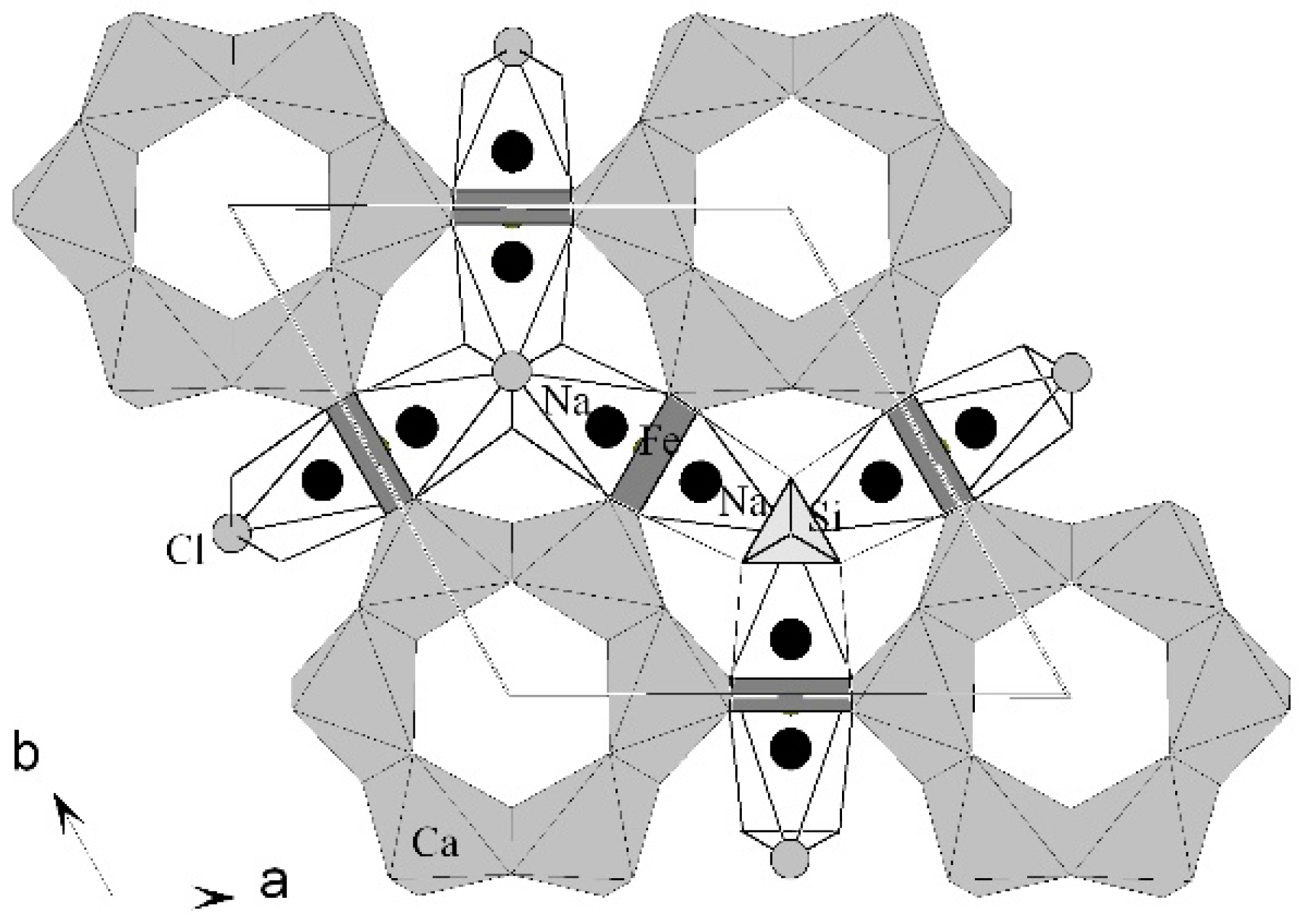New Data on the Isomorphism in Eudialyte-Group Minerals. 1. Crystal Chemistry of Eudialyte-Group Members with Na Incorporated into the Framework as a Marker of Hyperagpaitic Conditions
Abstract
1. Introduction
2. Materials and Methods
3. Results
3.1. Chemical Composition of Samples 1 and 2
3.2. Infrared Spectroscopy of Samples 1 and 2
3.3. Crystal Chemistry of Samples 1 and 2
4. Discussion
Author Contributions
Funding
Conflicts of Interest
References
- Sjöqvist, A.S.L. The tale of greenlandite: Commemorating the two-hundredth anniversary of eudialyte (1819–2019). Minerals 2019, 9, 497. [Google Scholar] [CrossRef]
- Rastsvetaeva, R.K.; Chukanov, N.V.; Aksenov, S.M. Minerals of Eudialyte Group: Crystal Chemistry, Properties, Genesis; University of Nizhni Novgorod: Nizhniy Novgorod, Russia, 2012; p. 230. ISBN 978-5-91326-207-3. (In Russian) [Google Scholar]
- Johnsen, O.; Grice, J.D.; Gault, R.A. The crystal chemistry of the eudialyte group. Canad. Mineral. 1999, 37, 865–891. [Google Scholar]
- Johnsen, O.; Ferraris, G.; Gault, R.A.; Grice, J.D.; Kampf, A.R.; Pekov, I.V. The nomenclature of eudialyte group minerals. Canad. Mineral. 2003, 41, 785–794. [Google Scholar] [CrossRef]
- Rastsvetaeva, R.K.; Khomyakov, A.P. Crystal chemistry of modular eudialytes. Crystallogr. Rep. 2003, 48, S78–S90. [Google Scholar]
- Rastsvetaeva, R.K. Structure mineralogy of eudialyte group. Crystallogr. Rep. 2007, 52, 50–67. [Google Scholar] [CrossRef]
- Rastsvetaeva, R.K.; Chukanov, N.V. Classification of eudialyte-group minerals. Geol. Ore Depos. 2012, 54, 487–497. [Google Scholar] [CrossRef]
- Rastsvetaeva, R.K.; Chukanov, N.V.; Aksenov, S.M. Crystalchemical principles of classifying the Eudialyte group. In Proceedings of the 35th International Geological Congress, Cape Town, South Africa, 27 August–4 September 2016; p. 4193. [Google Scholar]
- Rastsvetaeva, R.K.; Aksenov, S.M.; Rozenberg, K.A. Crystal structure and genesis of hydrated analog of rastsvetaevite. Crystallogr. Rep. 2015, 60, 897–905. [Google Scholar] [CrossRef]
- Rozenberg, K.A.; Rastsvetaeva, R.K.; Aksenov, S.M. Crystal structure of modular sodium-rich and low-iron eudialyte from Lovozero alkaline massif. Crystallogr. Rep. 2016, 61, 779–785. [Google Scholar] [CrossRef]
- Rastsvetaeva, R.K.; Rozenberg, K.A.; Chukanov, N.V.; Aksenov, S.M. Crystal structure of ilyukhinite, a new mineral of the eudialyte group. Crystallogr. Rep. 2017, 62, 60–65. [Google Scholar] [CrossRef]
- Chukanov, N.V.; Rastsvetaeva, R.K.; Rozenberg, K.A.; Aksenov, S.M.; Pekov, I.V.; Belakovsky, D.I.; Kristiansen, R.; Van, K.V. Ilyukhinite, (H3O,Na)14Ca6Mn2Zr3Si26O72(OH)2·3H2O, a new mineral of the eudialyte group. Geol. Ore Depos. 2017, 59, 592–600. [Google Scholar] [CrossRef]
- Rastsvetaeva, R.K.; Rozenberg, K.A.; Aksenov, S.M. Modular structure of highly ordered eudialyte and its place among hydrated minerals of rastsvetaevite family. Crystallogr. Rep. 2017, 62, 551–557. [Google Scholar] [CrossRef]
- Zaitsev, V.A.; Aksenov, S.M.; Rastsvetaeva, R.K.; Chukanov, N.V. Sr-rich eudialyte group mineral (Cl-deficient analogue of taseqite) from the Odikhincha Massif, Polar Siberia, Russia. In Proceedings of the XXXIV International Conference “Magmatism of the Earth and related strategic metal deposits”, Miass, Russia, 4–9 August 2017; pp. 319–321. [Google Scholar]
- Aksenov, S.M.; Zaitsev, V.A.; Rastsvetaeva, R.K.; Chukanov, N.V. Crystal Structure Features of Cl-Deficient Analogue of Taseqite from the Odichincha Massif (Russia); Abstracts of XII L.L; Perchuk International School of Earth Sciences (I.S.E.S.-2017); Institute of Mineralogy of the Ural Branch of the Russian Academy of Science: Miass, Russia, 2017; Volume 7. [Google Scholar]
- Rastsvetaeva, R.K.; Chukanov, N.V.; Zaitsev, B.A.; Aksenov, S.M.; Viktorova, K.A. Crystal structure of Cl-deficiente analog of tasekite from the Odihincha massif. Crystallogr. Rep. 2018, 63, 392–400. [Google Scholar] [CrossRef]
- Rastsvetaeva, R.K.; Chukanov, N.V.; Viktorova, K.A.; Aksenov, S.M. New data on the Isomorphism in eudialyte-group minerals. I. Crystal structure of titanium-rich eudialyte from the Kovdor alkaline massif. Crystallogr. Rep. 2018, 63, 563–569. [Google Scholar] [CrossRef]
- Rastsvetaeva, R.K.; Viktorova, K.A.; Aksenov, S.M. New data on the Isomorphism in Eudialyte-Group Minerals. II. Refinement of the aqualite crystal structure at 110 K. Crystallogr. Rep. 2018, 63, 884–889. [Google Scholar] [CrossRef]
- Chukanov, N.V.; Rastsvetaeva, R.K.; Kruszewski, Ł.; Aksenov, S.M.; Rusakov, V.S.; Britvin, S.N.; Vozchikova, S.A. Siudaite, Na8(Mn2+2Na)Ca6Fe3+3Zr3NbSi25O74(OH)2Cl·5H2O, a new eudialyte-group mineral from the Khibiny alkaline massif, Kola Peninsula. Phys. Chem. Min. 2018, 45, 745–758. [Google Scholar] [CrossRef]
- Rastsvetaeva, R.K.; Viktorova, K.A.; Aksenov, S.M. New Data on the Isomorphism in Eudialyte-Group Minerals. III. Modular structure of K-analog of centrosymmetrical labyrinthite. Crystallogr. Rep. 2019, 64, 203–208. [Google Scholar] [CrossRef]
- Rastsvetaeva, R.K.; Viktorova, K.A.; Aksenov, S.M. New data on the isomorphism in eudialyte-group minerals. IV. Modular structure of titanosilicate with replacement of Na by Mn in the alluaivite module. Crystallogr. Rep. 2019, 64, 561–564. [Google Scholar] [CrossRef]
- Rastsvetaeva, R.K.; Aksenov, S.M.; Chukanov, N.V. New data on crystal chemistry of eudialyte-group minerals. In Proceedings of the XIX International Meeting on Crystal Chemistry, X-ray Diffraction and Spectroscopy of Minerals, Apatity, Russia, 2–8 July 2019. Book of Abstracts, 81. [Google Scholar]
- Rastsvetaeva, R.K.; Aksenov, S.M.; Chukanov, N.V. New data on the crystal chemistry and systematics of minerals of eudialyte group. Cryst. Probl. 2019, 7, 192–202. (In Russian) [Google Scholar]
- Rastsvetaeva, R.K.; Chukanov, N.V.; Pekov, I.V.; Varlamov, D.A. Structural features of potential new mineral of eudialyte group from the Lovozero massif, Kola peninsula. Vestn. Geosci. 2020, 1, 3–7. [Google Scholar] [CrossRef]
- Rastsvetaeva, R.K.; Chukanov, N.V.; Möckel, S.; Dudka, A.P.; Aksenov, S.M. New data on the isomorphism in eudialyte-group minerals. V. Crystal structure of an intermediate member of the manganoeudialyte‒ilyukhinite isomorphous Series. Crystallogr. Rep. 2020, 65, 32–37. [Google Scholar] [CrossRef]
- Rastsvetaeva, R.K.; Chukanov, N.V.; Pekov, I.V.; Varlamov, D.A.; Aksenov, S.M. New data on the isomorphism in eudialyte-group minerals. VI. Crystal structure of the first member containing sulfide anion with isomorphic substitution Cl––S2–. Crystallogr. Rep. 2020, 65, 215–222. [Google Scholar] [CrossRef]
- Rastsvetaeva, R.K.; Chukanov, N.V.; Van, K.V. New Data on the isomorphism in eudialyte-group minerals. VII. Crystal structure of the eudialyte–sergevanite mineral series from the Lovozero alkaline massif. Crystallogr. Rep. 2020, 65, 555–561. [Google Scholar] [CrossRef]
- Rastsvetaeva, R.K.; Chukanov, N.V.; Sipavina, L.V.; Voronin, M.V. New data on the isomorphism in eudialyte-group minerals. VIII. Crystal structure of Fe2+-analog of Fe2+-analog feklichevite–potentionally new mineral from the Khibiny massif. Crystallogr. Rep. 2020, 65. in press. [Google Scholar]
- Rastsvetaeva, R.K.; Chukanov, N.V.; Lisitsin, D.V. New data on the isomorphism in eudialyte-group minerals. IX. Block isomorphism in key sites. Crystal structure of a Fe-deficient eudialyte from the Khibiny Massif. Crystallogr. Rep. 2020, 65. in press. [Google Scholar] [CrossRef]
- Rastsvetaeva, R.K.; Chukanov, N.V. New data on the isomorphism in eudialyte-group minerals. X. Specific features of isomorphism in the raslakite–sergevanite solid-solution series. Crystal structure of an intermediate member. Crystallogr. Rep. 2021, 66. in press. [Google Scholar]
- Rastsvetaeva, R.K.; Chukanov, N.V. Crystal Chemistry of Na-Dominant (at the M2 Site) Eudialyte Group Minerals as Indicators of Hyperalkaline Formations. Russian Conference with International Participation «Modern Problems of Theoretical, Experimental and Applied Mineralogy» (Yuschkinskie Reports-2020); 2020; in press. [Google Scholar]
- Rozenberg, K.A.; Rastsvetaeva, R.K.; Verin, I.A. Crystal structure of centrosymmetrical 12-layer high sodium eudialyte. Crystallogr. Rep. 2009, 54, 446–450. [Google Scholar] [CrossRef]
- Rozenberg, K.A.; Rastsvetaeva, R.K.; Khomyakov, A.P. Decationized and hydrated eudialytes. Oxonium problem. Eur. J. Mineral. 2005, 17, 875–882. [Google Scholar] [CrossRef]
- Rastsvetaeva, R.K.; Khomyakov, A.P. The crystal structure of the low-iron analogue of eudialyte. Doklady Akademii Nauk 1998, 362, 784–788. [Google Scholar]
- Rastsvetaeva, R.K.; Karipidis, T.K. Cationic ordering in the structure of titanium-rich eudialytes. In Proceedings of the 11th international conference “Order-Disorder in Minerals and alloys (OMA)”, Rostov-on–Don, Russia, 30 September–8 October 2008; Part II. pp. 138–141. (In Russian). [Google Scholar]
- Ekimenkova, I.A.; Rastsvetaeva, R.K.; Chukanov, N.V. Ordering of calcium and iron in a mineral of the eudialyte group with the symmetry R3. Doklady Chem. 2000, 374, 195–198. [Google Scholar]
- Chukanov, N.V.; Pekov, I.V.; Zadov, A.E.; Korovushkin, V.V.; Ekimenkova, I.A.; Rastsvetaeva, R.K. Ikranite (Na,H3O)15(Ca,Mn,REE)6Fe3+2Zr3(☐,Zr)(☐,Si)Si24O66(O,OH)6Cl⋅nH2O and raslakite Na15Ca3Fe3(Na,Zr)3Zr3(Si,Nb)(Si25O73)(OH,H2O)3(Cl,OH)–new minerals of the eudialyte-group from Lovozero massif. Geol. Ore Depos. 2003, 5, 22–33. [Google Scholar]
- Rastsvetaeva, R.K.; Aksenov, S.M.; Chukanov, N.V. Crystal structure of the Mn analogue of raslakite, a new representative of the eudialyte group. Doklady Chem. 2010, 431, 76–81. [Google Scholar] [CrossRef]
- Rastsvetaeva, R.K.; Khomyakov, A.P. Crystal structure features of Na,Fe-decationized eudialyte with R3 symmetry. Crystallogr. Rep. 2002, 47, 267–271. [Google Scholar] [CrossRef]
- Khomyakov, A.P.; Nechelyustov, G.N.; Rastsvetaeva, R.K. Aqualite (H3O)8(Na,K,Sr)5Ca6Zr3Si26O66(OH)9Cl —A new mineral of eudialyte-group from the alkaline Inagli massif, Saha-Yakutiya, Russia, and oxonium problem in hydrated eudialytes. Geol. Ore Depos. 2007, 136, 39–55. [Google Scholar]
- Rastsvetaeva, R.K.; Khomyakov, A.P.; Nekrasov, Y.V. Crystal structure of a new eudialyte analog with R3 symmetry. Crystallogr. Rep. 1999, 44, 824–828. [Google Scholar]
- Rastsvetaeva, R.K.; Khomyakov, A.P. Crystal structure of hyperzirconium analog of eudialyte. Crystallogr. Rep. 2000, 45, 251–253. [Google Scholar] [CrossRef]
- Aksenov, S.M.; Rastsvetaeva, R.K. Refinement of the crystal structure of hyperzirconium eudialyte and its place among low calcium minerals of the eudialyte-group. Crystallogr. Rep. 2013, 58, 555–561. [Google Scholar] [CrossRef]
- Rastsvetaeva, R.K.; Khomyakov, A.P.; Andrianov, V.I.; Gusev, A.I. Crystal structure of allyaivite. Doklady Akademii Nauk SSSR 1990, 312, 1379–1383. (In Russian) [Google Scholar]
- Rastsvetaeva, R.K.; Khomyakov, A.P.; Chapuis, G. Crystal structure and crystal-chemical features of a new Ti-rich member of the eudialyte family. Z. Krist. 1999, 214, 271–278. [Google Scholar] [CrossRef]
- Khomyakov, A.P.; Nechelyustov, G.N.; Rastsvetaeva, R.K. Dualite Na30(Ca,Na,Ce,Sr)12(Na,Mn,Fe,Ti)6Zr3Ti3Si51O144(OH,H2OCl)9 —A new zircono-titanium silicate with modular eudialyte like structure from the Lovozero alkaline massif, Kola peninsula, Russia. Geol. Ore Depos. 2007, 4, 31–42. [Google Scholar]
- Rastsvetaeva, R.K.; Khomyakov, A.P. Modular structure of high sodium eudialyte analog with doubled c-period and R3 symmetry. Crystallogr. Rep. 2001, 46, 827–832. [Google Scholar]
- Khomyakov, A.P.; Nechelyustov, G.N.; Rastsvetaeva, R.K. Labyrinthite (Na,K,Sr)35Ca12Fe3Zr6TiSi51O144(O,OH,H2O)9Cl3 —A new mineral with modular eudialyte-like structure from the Khibiny alkaline massif, Kola peninsula, Russia. Geol. Ore Depos. 2006, 2, 38–49. [Google Scholar]
- Khomyakov, A.P.; Nechelyustov, G.N.; Arakcheeva, A.V. Rastsvetaevite Na27K8Ca12Fe3Zr6Si4[Si3O9]4[Si9O27]4(O,OH,H2O)6Cl2—A new mineral with modular eudialyte-like structure and crystal-chemical systematics of eudialyte group. Geol. Ore Depos. 2006, 1, 49–65. [Google Scholar]
- Rastsvetaeva, R.K.; Khomyakov, A.P. Modular structure of a high-potassium analog of eudialyte with a doubled period c. Crystallogr. Rep. 2001, 46, 715–721. [Google Scholar]
- Rastsvetaeva, R.K.; Ivanova, A.G.; Khomyakov, A.P. Modular structure of hypermanganese eudialyte. Doklady Earth Sci. 2006, 410, 1075–1079. [Google Scholar] [CrossRef]
- Golyshev, V.M.; Simonov, B.I.; Belov, N.B. On the crystal structure of eudialyte. Kristallografiya 1971, 16, 93–98. (In Russian) [Google Scholar]
- Golyshev, V.M.; Simonov, B.I.; Belov, N.B. The crystal structure of eudialyte. Kristallografiya 1972, 17, 1119–1123. (In Russian) [Google Scholar]
- Giuseppetti, G.; Mazzi, F.; Tadini, C. The crystal structure of eudialyte. Tschermaks Mineral. Petrogr. Mitt. 1971, 16, 105–127. [Google Scholar] [CrossRef]
- Khomyakov, A.P. Mineralogy of Ultra-Agpaitic Alkaline Rocks; Nauka: Moscow, Russia, 1990; 196p. [Google Scholar]
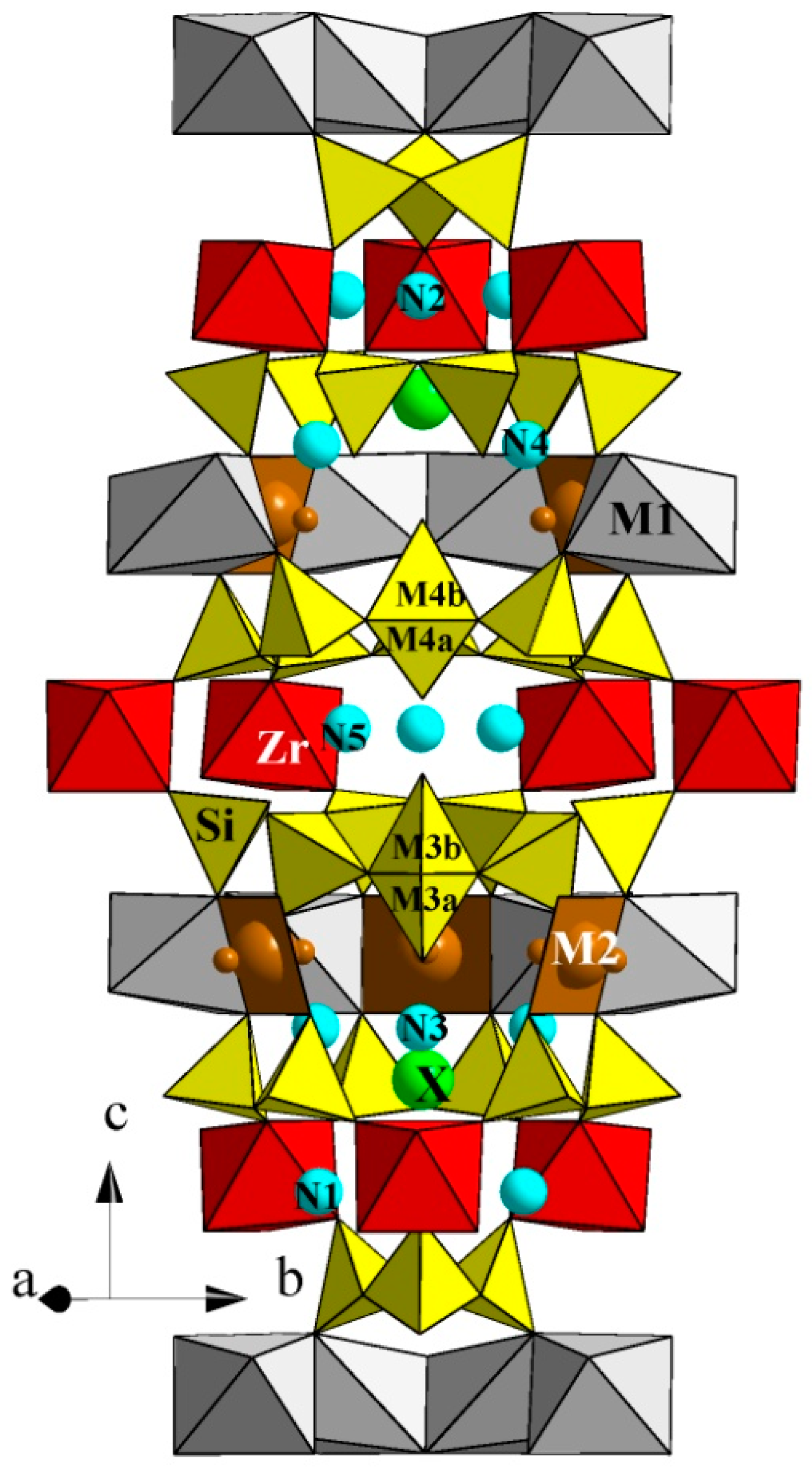
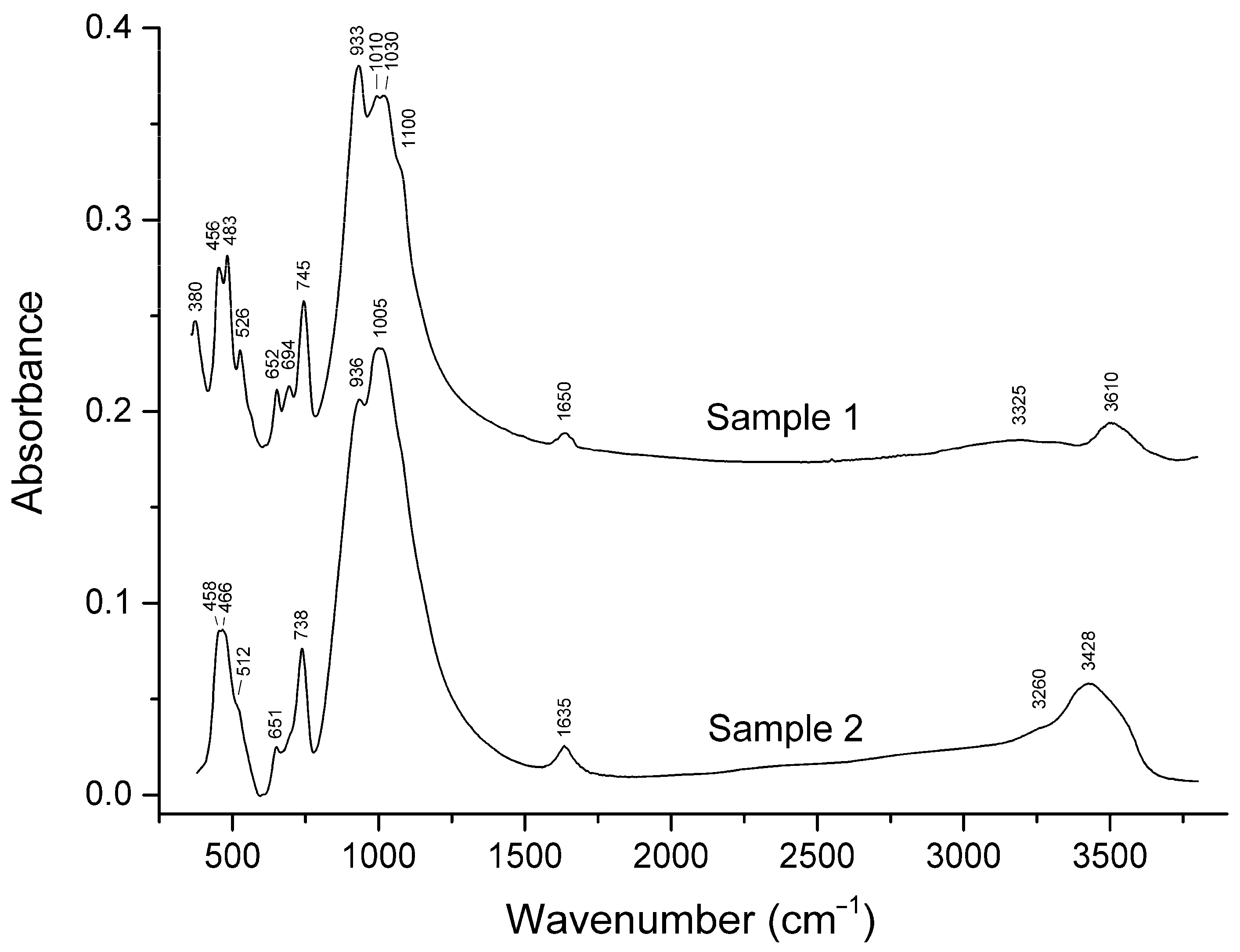
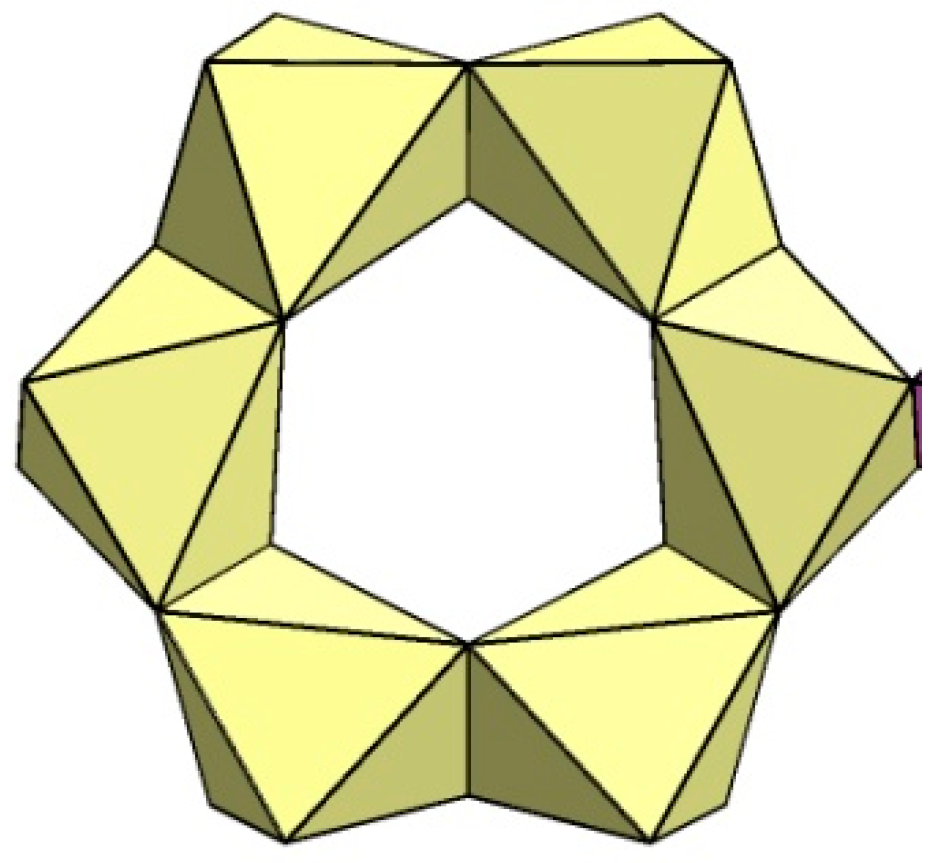

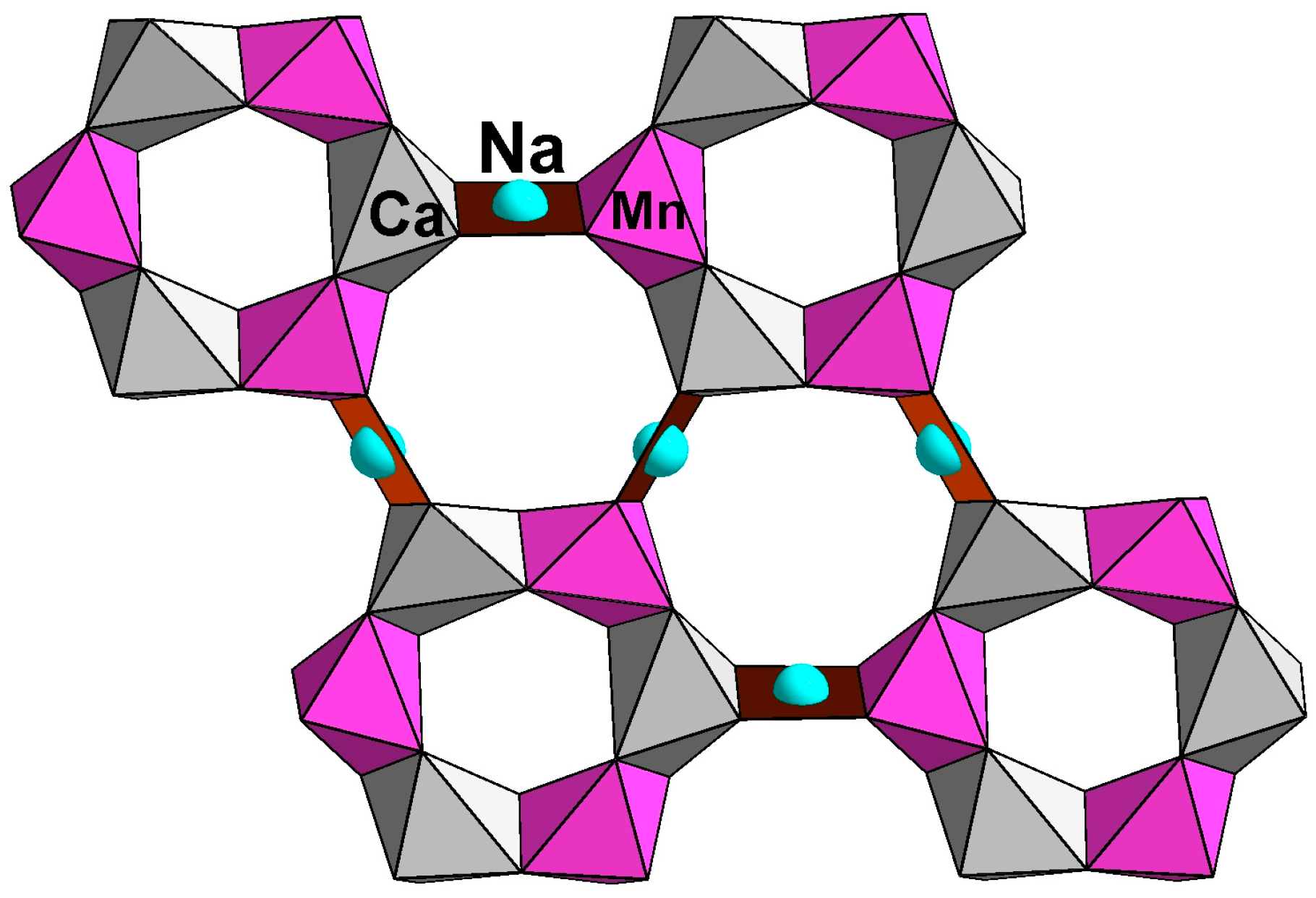
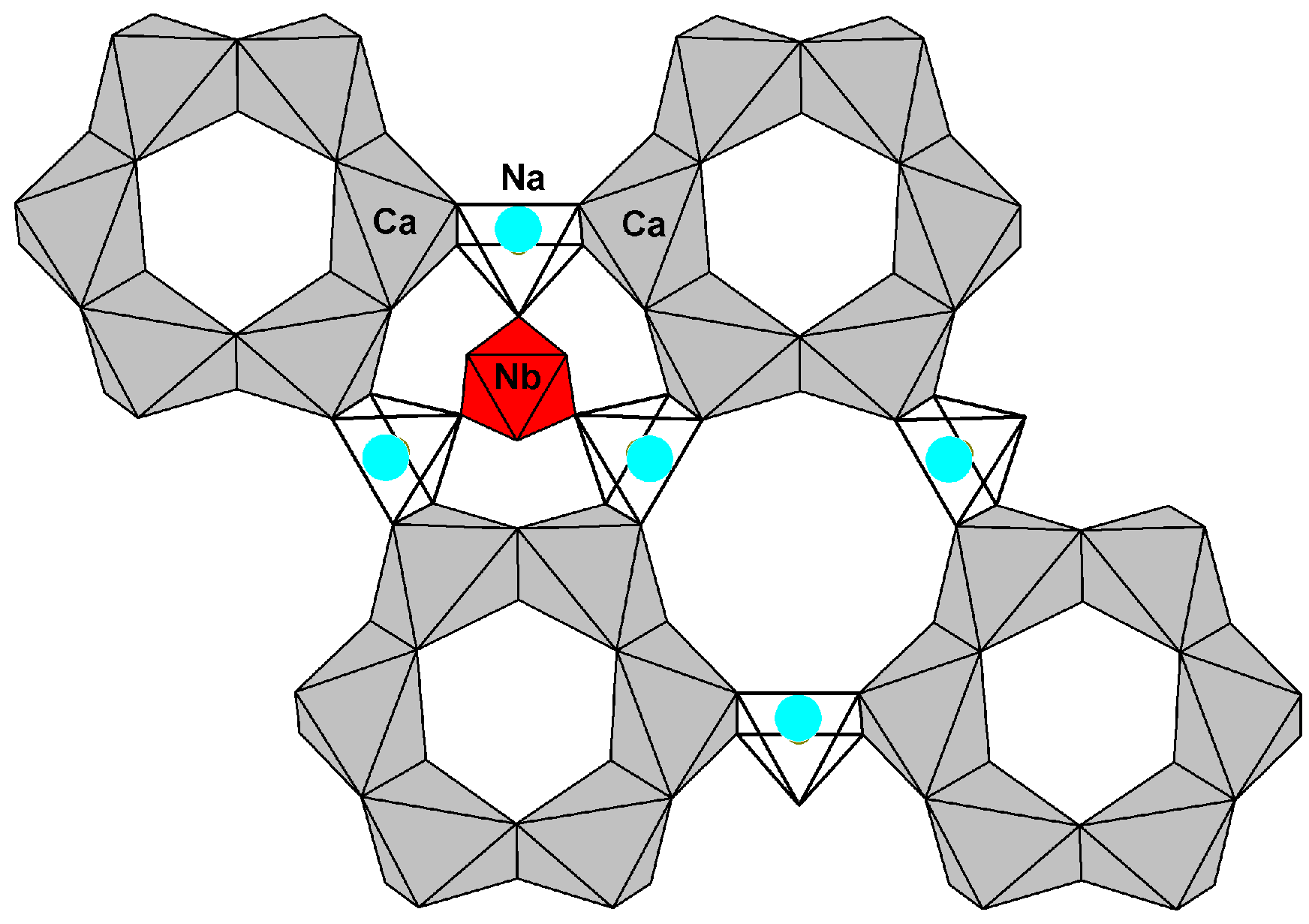
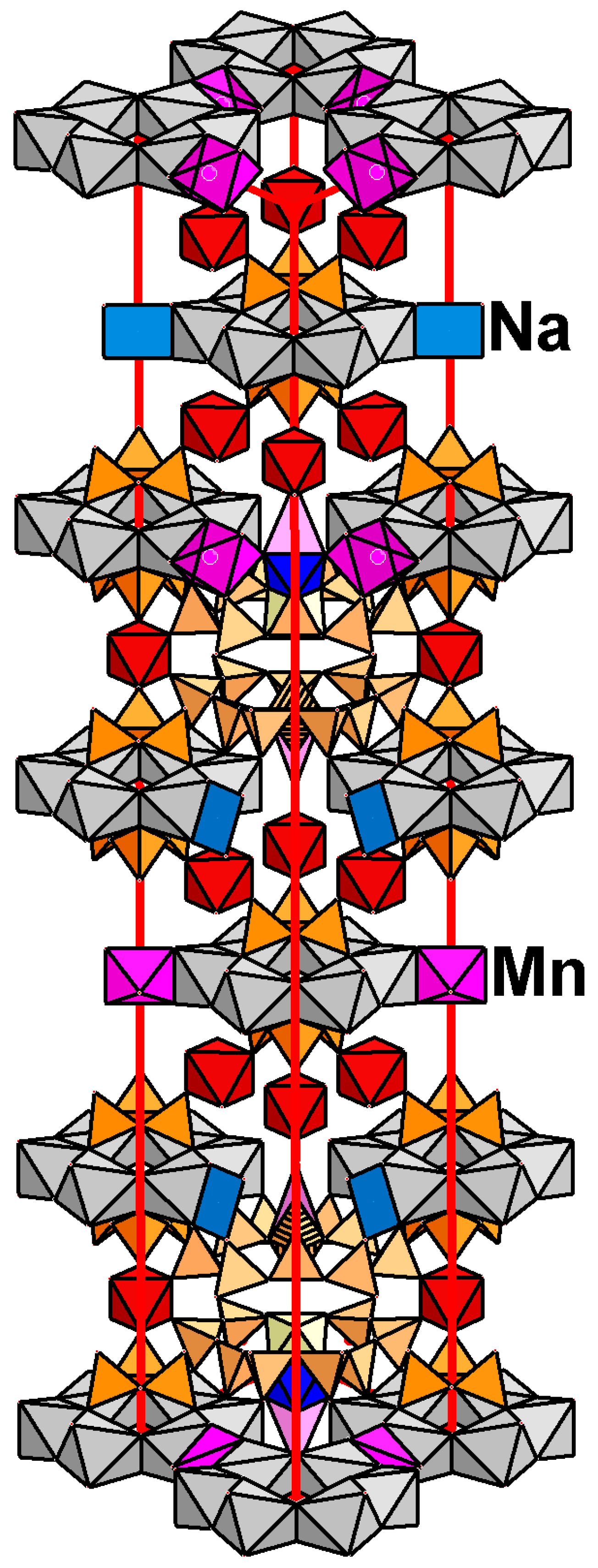
| Mineral | Simplified formula (Z = 3) |
|---|---|
| Eudialyte | N1-N5Na15M1Ca6M2Fe2+3ZZr3M3,M4[Si2] [Si24O72](O,OH,H2O)3(Cl,OH)2 |
| Mangano- eudialyte | N1-N5Na14M1Ca6M2Mn3ZZr3M3,M4[Si2] (Si24O72)[(OH)2Cl2]·4H2O |
| Fengchenite | N1-N5 [Na12☐3]M1(Ca,Sr)6 M2Fe3+3 ZZr3 M3,M4[Si2] (Si24O72)(H2O,OH,O)3(OH,Cl)2 |
| Feklichevite | N1-N5[Na11Ca3] M1Ca6M2Fe3+2ZZr3M3,M4[SiNb] (Si24O72)(OH,H2O,Cl,O)5 |
| Golyshevite | N1-N5[(Na,Ca)10 Ca3] M1Ca6 M2Fe3+2 ZZr3 M3,M4[SiNb] (Si24O72)(CO3)(OH)3·H2O |
| Taseqite | N1-N5(Na12Sr3) M1Ca6M2Fe2+3ZZr3M3,M4[SiNb] (Si24O72)(O,OH,H2O)4Cl2 |
| Mogovidite | N1-N5[Na9(Ca,Na)6] M1Ca6M2Fe3+2ZZr3M3,M4[☐Si] (Si24O72)CO3)(OH,H2O) |
| Voronkovite | N1-N5Na15M1[(Na,Ca,Ce)3(Mn,Ca)3] M2Fe2+3ZZr3M3,M4[Si2] (Si24O72)(OH,O)4Cl·H2O |
| Georgbarsanovite | N1-N5[Na12 Mn3] M1Ca6 M2Fe2+3 ZZr3 M3,M4[SiNb] (Si24O72)(O,OH,F)4Cl·H2O |
| Kentbrooksite | N1-N5(Na,REE)15M1(Ca,REE)6M2Mn3ZZr3M3,M4[SiNb] (Si24O74)F2·2H2O |
| Ferrokent- brooksite | N1-N5 Na15 M1Ca6 M2Fe2+3 ZZr3 M3,M4[SiNb] (Si24O73)(O,OH,H2O)4(Cl,F,OH)2 |
| Carbokent- brooksite | N1-N5(Na,☐,REE)15M1Ca6M2Mn3ZZr3M3,M4[SiNb] (Si24O74)O(OH)3(CO3)·H2O |
| Zirsilite-(Ce) | N1-N5[(Na,☐)12(Ce,Na)3] M1Ca6M2Mn3ZZr3M3,M4[SiNb] (Si24O74)O(OH)3(CO3)·H2O |
| Ikranite | N1-N5(Na,H3O)15M1(Ca,Mn,REE)6M2Fe3+ZZr3M3,M4[(☐,Zr)(☐,Si)] Si24O66(O,OH)6Cl·nH2O |
| Andrianovite | N1-N5[Na12(K,Sr,Ce)3 ] M1Ca6 M2Mn3ZZr3 M3,M4[SiNb] (Si24O73)(O,H2O,OH)5 |
| Davinciite | N1-N5[Na12K3] M1Ca6M2Fe2+3ZZr3M3,M4[Si2] [(Si24O73OH)]Cl2 |
| Ilyukhinite | N1-N5(H3O,Na)14M1Ca6 Mn2+2 ZZr3 M3,M4[Si2] [Si24O72(OH)2]·3H2O |
| Siudaite | N1-N5[(Na,H2O)12(Mn2+,Na)3] M1Ca6M2(Fe3+2Mn2+) ZZr3M3,M4[SiNb] [Si24O70(OH)2] (OH,O,H2O)5 |
| Raslakite | N1-N5Na15M1[Ca3Fe3] M2(Na,Zr)3ZZr3M3,M4[(Si,Nb)Si] (Si24O72) (OH,H2O,O)4(Cl,OH) |
| Sergevanite | N1-N5(Na,H3O)15M1(Ca3Mn2+3) M2(Na2Fe2+) ZZr3M3,M4[Si(Si,Ti)] [Si24O72] (OH,H2O,SO4)5 |
| Aqualite | N1-N5[(H3O)9 (K,Ba,Sr)2] M1Ca6 ZZr3 M2Na2 M3,M4[Si2] [Si24O66(OH)6](OH)3Cl·H2O |
| Oneillite | N1-N5 Na15 M1[Ca3Mn3] M2Fe3 ZZr3 M3,M4[SiNb] (Si24O72)(O,OH,H2O)4(Cl,OH)2 |
| Khomyakovite | N1-N5[Na12Sr3] M1Ca6M2Fe3ZZr3M3,M4[SiW] (Si24O72)(O,OH,H2O)4(OH,Cl)2 |
| Mangano- khomyakovite | N1-N5[Na12Sr3] M1Ca6M2Mn3ZZr3M3,M4[SiW] (Si24O72)(O,OH,H2O)4(OH,Cl)2 |
| Johnsenite-(Ce) | N1-N5[Na12(Ce,La,Sr,Ca,☐)3] M1Ca6M2Mn3ZZr3M3,M4[SiW] (Si24O72) (CO3)(O,OH,Cl)3 |
| Alluaivite | N1-N5(Na,☐)30M1(Ca,Mn)12M2Na4.6M3,M4Si4Z(Ti,Nb)6 [Si24O72]2 Cl2·nH2O |
| Dualite | N1-N5Na30M1(Ca,Na,Ce,Sr)12M2(Na,Mn,Fe,Ti) 6Z[Zr3Ti3] M3,M4[MnSi3] [Si48O144](OH,H2O,Cl]9 |
| Labyrinthite | N1-N5Na32M1Ca12M2[Na3Fe2☐] ZZr6M3,M4[Si3Ti] [Si3O9]4[Si9O27]4(O,OH)9Cl3 |
| Rastsvetaevite | N1-N5[Na26K6] M1Ca12M2[NaK2Fe3] ZZr6M3,M4[Si4] [Si3O9]4[Si9O27]4 (O,OH,H2O)6Cl |
| Sample 1 | N1-N5(Na,H3O)13M1(Ca,Mn)6) ZZr3M2[Na2Zr] M3,M4[Si2] [Si24O72](OH)2Cl·H2O |
| Sample 2 | N1-N5(Na,H3O)15M1Ca6ZZr3M2[Na2Fe] M3,M4[Si2][Si24O72](OH)2Cl·2H2O |
| Constituent | Sample 1 | Sample 2 | ||
|---|---|---|---|---|
| Mean | Ranges | Mean | Ranges | |
| Na2O | 13.81 | 13.42–14.17 | 11.13 | 10.38–11.71 |
| K2O | 0.27 | bdl–0.53 | bdl | bdl |
| CaO | 7.13 | 6.80–7.56 | 8.13 | 7.77–8.60 |
| MnO | 2.83 | 2.43–3.15 | 0.83 | 0.59–0.96 |
| FeO | 2.10 | 1.27–2.71 | 3.38 | 3.04–3.75 |
| SrO | 1.12 | 1.67–2.31 | bdl | bdl |
| Y2O3 | bdl | bdl | 1.08 | 0.72–1.27 |
| La2O3 | 0.91 | 0.68–1.15 | 1.85 | 1.63–2.05 |
| Ce2O3 | 1.06 | 0.86–1.39 | 2.12 | 1.88–2.40 |
| Nd2O3 | 0.34 | 0.21–0.48 | 0.50 | 0.41–0.66 |
| SiO2 | 49.97 | 49.05–50.89 | 53.60 | 52.59–54.82 |
| TiO2 | 0.87 | 0.69–1.04 | 0.92 | 0.76–1.18 |
| ZrO2 | 15.24 | 14.88–15.57 | 11.13 | 10.84–11.43 |
| HfO2 | 0.18 | bdl–0.30 | 0.23 | bdl–0.39 |
| Nb2O5 | 0.91 | 0.79–1.11 | 1.05 | 0.85–1.26 |
| SO3 | 0.38 | bdl–0.63 | 0.23 | bdl–0.37 |
| Cl | 0.93 | 0.70–1.27 | 0.43 | 0.36–0.48 |
| –O=Cl | −0.21 | −0.10 | ||
| Total | 97.84 | 96.51 | ||
| Sample 1 | Sample 2 | ||||||
|---|---|---|---|---|---|---|---|
| Site | Coord. Number | Ranges | Average | Site | Coord. Number | Ranges | Average |
| M1 | 6 | 2.295(8)–2.420(5) | 2.350 | M1 | 6 | 2.305(6)–2.394(3) | 2.338 |
| M2a | 7 | 2.328(9)–3.045(8) | 2.754 | M2a | 5 | 2.14(4)–2.34(1) | 2.24 |
| M2b | 5 | 2.138(5)–2.31(7) | 2.204 | M2b | 4 | 2.184(3)–2.184(3) | 2.184 |
| M3a | 6 | 1.614(9)–1.94(2) | 1.777 | M3a | 6 | 1.66(1)–1.99(4) | 1.83 |
| M3b | 4 | 1.28(3)–1.53(1) | 1.47 | M3c | 4 | 1.565(9)–1.67(3) | 1.59 |
| M3c | 4 | 1.602(7)–1.63(1) | 1.609 | ||||
| M4a | 4 | 1.535(2)–1.62(3) | 1.556 | ||||
| M4b | 4 | 1.611(4)–1.82(4) | 1.66 | ||||
| M4c | 6 | 1.79(8)–1.903(7) | 1.847 | ||||
| Sample No. | Lattice Parameters (a, c in Å); Space Group | Na-Polyhedra (Z = 3) | References |
| Eudialyte Structure Type | |||
| 1. | 14.198(1), 30.380(1); R3m | NaVII2.1 | [24] |
| 2. | 14.208(1), 30.438(2); R-3m | NaV2.01 | [31] |
| 3. | 14.226(4), 30.339(7); R-3m | NaVII2.2 | [32] |
| 4. | 14.199(1), 30.305(1); R3m | NaVI0.7 + NaV0.6 | [29] |
| 5. | 14.155(1), 30.998(1); R3m | NaIV2.3 | [33] |
| 6. | 14.081(1), 30.525(3); R3m | NaIV0.62 | [33] |
| 7. | 14.170(4), 30.38(2); R3m | NaIV2.4 | [34] |
| 8. | 14.165(1), 30.600(5); R3m | NaVI2.2 | [35] |
| 9. | 14.220(1), 30.539(1); R3m | NaV1.9 | [2] |
| Raslakite Structure Type | |||
| 10. | 14.208(1), 30.384(1); R3 | NaIV2.4 | [30] |
| 11. | 14.1944(4), 30.294(1); R3 | NaVII1.75 | [27] |
| 12. | 14.229(7), 30.019(5); R3 | NaV1.5 | [36,37] |
| 13. | 14.218(1), 30.349(2); R3 | NaIV1.8 + NaVI0.6 | [30,38] |
| 14. | 14.078(3), 31.24(1); R3 | NaIV2.2 | [39,40] |
| 15. | 14.182(7), 30.37(1); R3 | NaV1.8 | [41] |
| 16. | 14.222(3), 30.165(5); R3 | NaV0.9 + NaV0.45 | [42,43] |
| Alluaivite Structure Type | |||
| 17. | 14.046(2), 60.60(2); R-3m | NaIV3/NaVII2.34 | [44] |
| 18. | 14.069(4), 60.63(1); R-3m | NaIV3/NaIV1.59 | [21] |
| 19. | 14.153(9), 60.72(5); R3m | NaV1.5/NaV1.5 | [45,46] |
| 20. | 14.239(1), 60.733(7); R3 | NaIV1NaVII2/FeIV2.2 | [47,48] |
| 21. | 14.249(1), 60.969(1); R3m | NaIV1KVII2/FeIV3 | [49,50] |
| 22. | 14.179(1), 60.67(1); R-3m | NaIV2.4/MnV2.46 | [51] |
| 23. | 14.2032(1), 60.6118(7); R-3m | NaIV3/FeIV 1.25 | [10] |
© 2020 by the authors. Licensee MDPI, Basel, Switzerland. This article is an open access article distributed under the terms and conditions of the Creative Commons Attribution (CC BY) license (http://creativecommons.org/licenses/by/4.0/).
Share and Cite
Rastsvetaeva, R.K.; Chukanov, N.V.; Pekov, I.V.; Schäfer, C.; Van, K.V. New Data on the Isomorphism in Eudialyte-Group Minerals. 1. Crystal Chemistry of Eudialyte-Group Members with Na Incorporated into the Framework as a Marker of Hyperagpaitic Conditions. Minerals 2020, 10, 587. https://doi.org/10.3390/min10070587
Rastsvetaeva RK, Chukanov NV, Pekov IV, Schäfer C, Van KV. New Data on the Isomorphism in Eudialyte-Group Minerals. 1. Crystal Chemistry of Eudialyte-Group Members with Na Incorporated into the Framework as a Marker of Hyperagpaitic Conditions. Minerals. 2020; 10(7):587. https://doi.org/10.3390/min10070587
Chicago/Turabian StyleRastsvetaeva, Ramiza K., Nikita V. Chukanov, Igor V. Pekov, Christof Schäfer, and Konstantin V. Van. 2020. "New Data on the Isomorphism in Eudialyte-Group Minerals. 1. Crystal Chemistry of Eudialyte-Group Members with Na Incorporated into the Framework as a Marker of Hyperagpaitic Conditions" Minerals 10, no. 7: 587. https://doi.org/10.3390/min10070587
APA StyleRastsvetaeva, R. K., Chukanov, N. V., Pekov, I. V., Schäfer, C., & Van, K. V. (2020). New Data on the Isomorphism in Eudialyte-Group Minerals. 1. Crystal Chemistry of Eudialyte-Group Members with Na Incorporated into the Framework as a Marker of Hyperagpaitic Conditions. Minerals, 10(7), 587. https://doi.org/10.3390/min10070587




